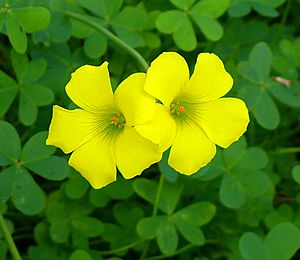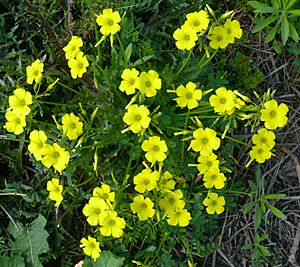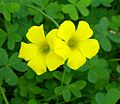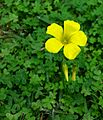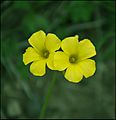Oxalis pes-caprae facts for kids
Oxalis pes-caprae is a common flowering plant. It's often called Bermuda buttercup, African wood-sorrel, or sourgrass. It gets the name "sourgrass" because its leaves and stems have a sour taste, like lemon. This plant is originally from South Africa.
Contents
What it Looks Like
The Oxalis pes-caprae plant has bright yellow flowers. Each flower has five petals that are joined together at the bottom. It also has five sepals, which are like small green leaves that protect the flower bud. Inside the flower, there are ten stamens (the parts that make pollen) and a pistil (the part that makes seeds).
One special thing about this plant is how it grows. It produces many small, true bulbs underground. These bulbs are like tiny onions and help the plant spread easily. When you pull up the plant, these small bulbs often stay in the soil, which makes it hard to get rid of.
An Invasive Plant
While Oxalis pes-caprae is native to South Africa, it has become an invasive species in many other parts of the world. An invasive species is a plant or animal that spreads to new areas and can harm the local environment. It can take over space from native plants and change the natural balance.
You can find Oxalis pes-caprae growing as an invasive weed in places like the United States (especially California), Europe, Israel, and Australia.
Controlling Its Spread
This plant is known for being very difficult to remove once it has spread. This is mainly because of its underground bulbs. When you pull the plant out of the ground, the small bulbs often break off and stay in the soil. These leftover bulbs can then grow into new plants. This means that soil where the plant has grown can have many tiny bulbs hidden in it, ready to sprout.
How People Use It
Oxalis pes-caprae is often called sourgrass or soursob because of its pleasant sour taste. This taste comes from a natural chemical called oxalic acid found in the plant.
In small amounts, the plant is safe for humans and animals to eat. In South Africa, it's even used as a traditional ingredient in some dishes, like a stew called waterblommetjiebredie.
People have used this plant in different ways. The fleshy underground runners, which are like thick stems, can be eaten raw or cooked. The bright yellow petals can also be used to make a yellow dye.
Things to Be Careful About
While Oxalis pes-caprae is generally safe in small amounts, oxalic acid can be harmful if eaten in very large quantities. This is a concern in places like southern Australia, where the plant grows in huge amounts.
Some people think that eating too much Oxalis can cause kidney stones. However, it's unlikely that a normal amount eaten by humans would cause this problem.
Even though it's mostly harmless, if a lot of Oxalis pes-caprae grows in pastures, it can sometimes cause problems for farm animals. For example, if hungry animals like sheep eat too much of the plant very quickly, it can make them sick or even be fatal. This has happened in places like South Australia.
In its native South Africa, Oxalis poisoning in animals is not a big problem, unless animals eat only this plant because there's nothing else to graze on.
Images for kids
See also
 In Spanish: Agrios para niños
In Spanish: Agrios para niños


